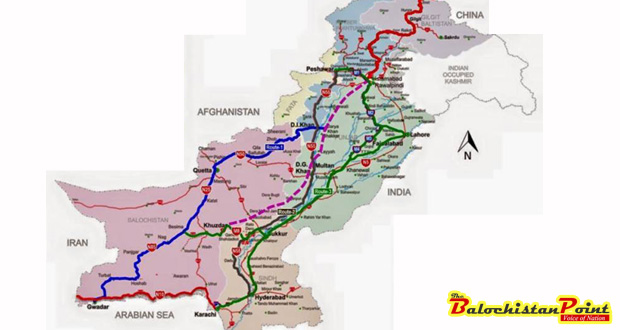Adnan Aamir
On May 28, all political parties of Pakistan reached a consensus on the route of China-Pakistan Economic Corridor (CEPC) in the All Parties Conference (APC). Although it’s good news but it comes as a big surprise because the federal government didn’t concede anything major to win over the support of political parties of Balochistan and Khyber Pakhtunkhwa (KP).
The federal government only conceded the following three points:
1) A road would be constructed that would connect Bajaur agency in FATA to D.I. Khan.
2) A parliamentary oversight board would be constituted to oversee the implementation of CPEC projects.
3) The western route of CPEC would be constructed first.
Here are the issues related to CPEC that still remain unsettled:
1) The eastern route that would pass through Sindh and Punjab comprises of a 6-Lane motorway whereas Western route would be a Grade-II route that would have 2 lanes maximum.
2) No headway was made on determining the revenue sharing formula of CPEC. Similarly, there was no mention of giving the Balochistan government control over Gwadar, as demanded by Awami National Party (ANP).
3) Ahsan Iqbal once again lied at the APC that the Orange Line mass rail system in Lahore is not a part of CPEC. In fact, this project is being financed by CPEC under MOU No. 27 signed between Pakistan and China.
The social media team of ANP termed consensus on CPEC as its victory. Similar claims were made by Pashtoonkhwa Milli Awami Party (PKMAP) and National Party (NP). These are, at best, absurd claims as all these parties didn’t achieve anything through that APC. In fact, the federal government had already announced before the APC that western route would be built in priority to eastern route. Farooq Sattar of MQM said that consensus has been reached on building western route first not on the entire CPEC. So, the changed stance of ANP, PKMAP, NP and other political parties from Balochistan and KP is nothing less than a huge U-turn which is tantamount to political opportunism.
Notwithstanding the fact that major reservations of Balochistan and KP about CPEC remain intact, political opposition to this project has ended for the time being. This is a welcome development given the economic plight of Pakistan and the need for an urgent stimulus to the economy. CPEC has been dubbed a “game changer” for the region and it can live up to that billing only if lesser developed provinces of Pakistan are its major beneficiaries.
In order to make CPEC a success and a real fate changer, ‘smaller’ provinces, especially Balochistan, should be facilitated in attaining the maximum possible benefits. Following are a few steps that should be taken to make CPEC a success in Balochistan:
Gwadar port is the reason that $46 billion CPEC project has materialized into reality. Gwadar town in 21st century presents the picture of Stone Age where people don’t have clean drinking water, among other problems. Therefore, a massive development project should be initiated for socio-economic development of the natives of Gwadar.
The Gwadar Port project must be in complete control of Balochistan government. The centralized nature of federation of Pakistan is the major cause of inter-provincial discord in Pakistan and if Gwadar Port continues to be in federal control then this discord will exacerbate. So, all matters pertaining to Gwadar port should be brought under the ambit of Balochistan government.
As a part of CPEC, several industrial zones would be built in different provinces. These zones would be a source of employment for the people. In the case of Balochistan, the provincial government should have the say in deciding the location of these zones. The people of Balochistan should form 100% of labor force of industrial zones in the province. If people from other provinces are hired in the industrial zones of Balochistan then it would give rise to another conflict which will not bode well for the future of CPEC.
$33 billion from the funds of CPEC will be used for the energy projects which would add up to 16,000 Megawatt (MW) of electricity in the National Grid. Balochistan, at the moment is the biggest victim of electricity load shedding in the country. Despite producing 2,200 MW of electricity this province hardly gets 500 MW. Therefore, it should be ensured that complete the electricity demand of Balochistan, which is just 1,800 MW, should be fulfilled by the proposed energy projects in CPEC.
The trade route of CPEC connecting Gwadar with Kashghar will attract massive traffic in years to come. This would not only result in increased economic activity in Pakistan but huge amount of revenues would also be earned. It’s pivotal that a revenue sharing formula must be devised to divide the revenues of CPEC among all provinces and federal government on rational basis. Balochistan being the center stage of Gwadar port should have the lion’s share in the total revenue of CPEC.
Lastly, the federal government has to stop the trend of declaring the people of ‘smaller’ provinces traitors when they raise voice for their genuine rights. Consensus has been reached on CPEC at the moment but given differences can appear on several issues in future to come. At that point, the federal government should be prepared to address the concerns of ‘smaller’ provinces in an amicable way rather than decorating their leaders with labels of RAW agents.
Author is the Editor of The Balochistan Point
Courtesy: The Nation
Republished in The Balochistan Point on June 8, 2015
 Balochistan Point Voice of Nation
Balochistan Point Voice of Nation




